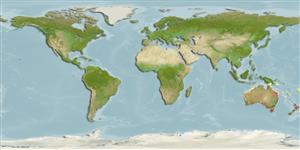>
Syngnathiformes (Pipefishes and seahorses) >
Syngnathidae (Pipefishes and seahorses) > Syngnathinae
Etymology: Urocampus: Greek, oura = tail + greek, kampe = curved (Ref. 45335).
More on author: Castelnau.
Environment: milieu / climate zone / depth range / distribution range
Ekologi
laut; payau dasar (demersal); kisaran kedalaman 0 - 5 m (Ref. 5316). Tropical; 8°S - 45°S
Western Pacific: Australia and Papua New Guinea.
Size / Weight / umur
Maturity: Lm ? range ? - ? cm
Max length : 10.0 cm SL jantan/; (Ref. 31838)
Duri punggung (Keseluruhan (total)): 0; duri punggung lunak (Keseluruhan (total)): 13-15; Duri dubur 0; Sirip dubur lunak: 2. Small and slender, and have a short, thick snout, continuous superior trunk and tail ridges, small pectoral fins, and a dorsal fin that originates on tail rings 5-9. Body usually has numerous hair-like appendages which provide camouflage.
Inhabit lower reaches of rivers, estuaries or other protected inshore habitats (Ref. 5316). Found mostly in algal or Zostera beds (Ref. 5316), rarely at depths of more than a few meters (Ref. 31838). Ovoviviparous (Ref. 205). The male carries the eggs in a brood pouch which is found under the tail (Ref. 205).
Male carries the eggs in a brood pouch (Ref. 205). Up to 20 eggs are incubated by the male in a brood pouch formed from laterally expanded flaps of skin on the underside of the tail. Newly emerged larvae may remain in the pouch (Ref. 31838).
Paxton, J.R., D.F. Hoese, G.R. Allen and J.E. Hanley, 1989. Pisces. Petromyzontidae to Carangidae. Zoological Catalogue of Australia, Vol. 7. Australian Government Publishing Service, Canberra, 665 p. (Ref. 7300)
Status IUCN Red List (Ref. 130435)
ancaman kepada manusia
Harmless
penggunaan manusia
informasi lanjut
Umur / SaizPertumbuhanpanjang-beratpanjang-panjangukuran frekuensiMorfometrikMorfologiLarvaDinamika larvapemulihanKelimpahanBRUVS
AcuanBudidaya airprofil budidaya airStrainGenetikaElectrophoresesDiturunkanPenyakit-penyakitPengolahanNutrientsMass conversion
mitraGambarStamps, Coins Misc.Suara-suaraCiguateraKecepatanTipe renangArea insangOtolithsOtakPenglihatan / visi
Alat, peralatan
laporan khas
muat turun XML
Sumber internet
Estimates based on models
Preferred temperature (Ref.
123201): 14.6 - 25.5, mean 18.3 °C (based on 410 cells).
Phylogenetic diversity index (Ref.
82804): PD
50 = 0.7500 [Uniqueness, from 0.5 = low to 2.0 = high].
Bayesian length-weight: a=0.00037 (0.00016 - 0.00085), b=3.18 (2.99 - 3.37), in cm total length, based on LWR estimates for this (Sub)family-body shape (Ref.
93245).
Trophic level (Ref.
69278): 3.0 ±0.1 se; based on diet studies.
Daya lenting (Ref.
120179): Rendah, Waktu penggandaan populasi minimum 4.5 - 14 tahun (Fec=20).
Fishing Vulnerability (Ref.
59153): Low vulnerability (10 of 100).
